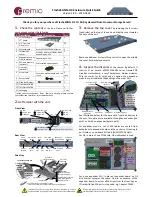
Intel® Server Board S2600CW Family TPS
Intel® Server Board S2600CW Platform Management
Revision 2.4
75
5.3.12.1
DIMM Voltage Sensors
Some systems support either LVDDR (Low Voltage DDR) memory or regular (non-LVDDR)
memory. During POST, the system BIOS detects which type of memory is installed and
configures the hardware to deliver the correct voltage.
Since the nominal voltage range is different, this necessitates the ability to set different
thresholds for any associated IPMI voltage sensors. The BMC FW supports this by
implementing separate sensors (that is, separate IPMI sensor numbers) for each nominal
voltage range supported for a single physical sensor and it enables/disables the correct IPMI
sensor based on which type memory is installed. The sensor data records for both these DIMM
voltage sensor types have scanning disabled by default. Once the BIOS has completed its
POST routine, it is responsible for communicating the DIMM voltage type to the BMC which
will then enable sensor scanning of the correct DIMM voltage sensor.
5.3.13
Fan Monitoring
BMC fan monitoring support includes monitoring of fan speed (RPM) and fan presence.
5.3.13.1
Fan Tach Sensors
Fan tach sensors are used for fan failure detection. The reported sensor reading is
proportional to the fan’s RPM. This monitoring capability is instantiated in the form of IPMI
analog/threshold sensors.
Most fan implementations provide for a variable speed fan, so the variations in fan speed can
be large. Therefore the threshold values must be set sufficiently low as to not result in
inappropriate threshold crossings.
Fan tach sensors are implemented as manual re-arm sensors because a lower-critical
threshold crossing can result in full boosting of the fans. This in turn may cause a failing fan’s
speed to rise above the threshold and can result in fan oscillations.
As a result, fan tach sensors do not auto-rearm when the fault condition goes away but rather
are rearmed for either of the following occurrences:
1.
The system is reset or power-cycled.
2.
The fan is removed and either replaced with another fan or re-inserted. This applies to
hot-swappable fans only. This re-arm is triggered by change in the state of the
associated fan presence sensor.
After the sensor is rearmed, if the fan speed is detected to be in a normal range, the failure
conditions shall be cleared and a de-assertion event shall be logged.
5.3.13.2
Fan Presence Sensors
Some chassis and server boards provide support for hot-swap fans. These fans can be
removed and replaced while the system is powered on and operating normally. The BMC
Содержание S2600CW
Страница 9: ...Intel Server Board S2600CW Family TPS Table of Contents Revision 2 4 ix ...
Страница 14: ...List of Tables Intel Server Board S2600CW Family TPS Revision 2 4 xiv This page intentionally left blank ...
Страница 108: ...Intel Server Board S2600CW Platform Management Intel Server Board S2600CW Family TPS 94 Revision 2 4 ...
Страница 184: ...Appendix C BMC Sensor Tables Intel Server Board S2600CW Family TPS 170 Revision 2 4 ...
















































